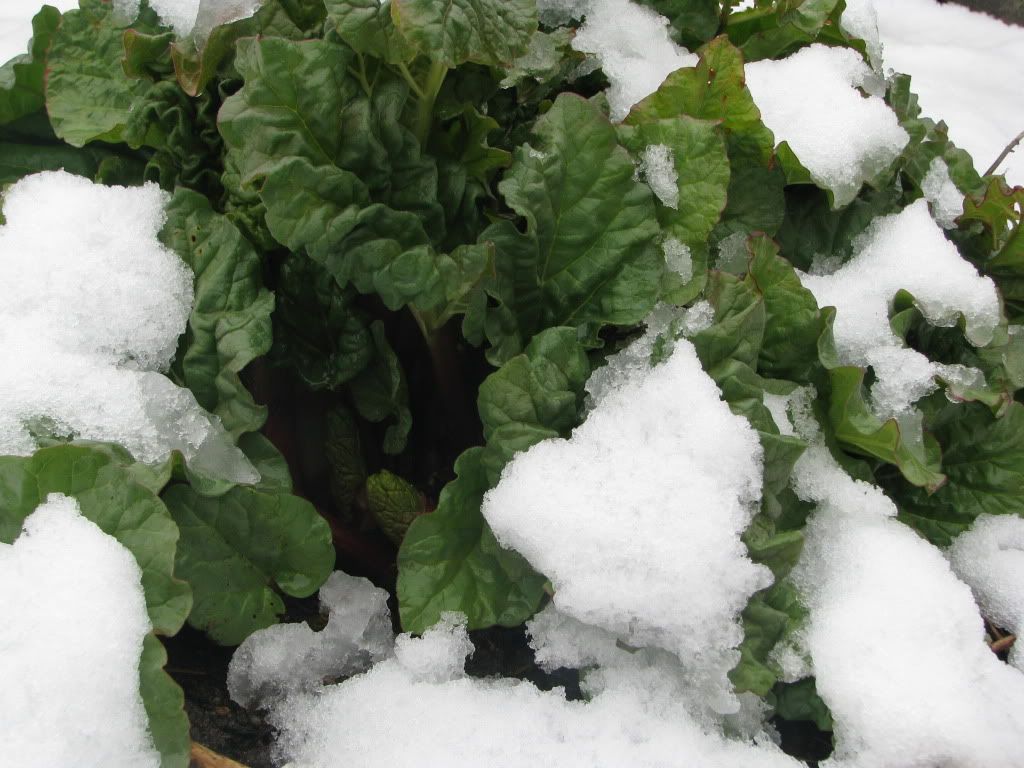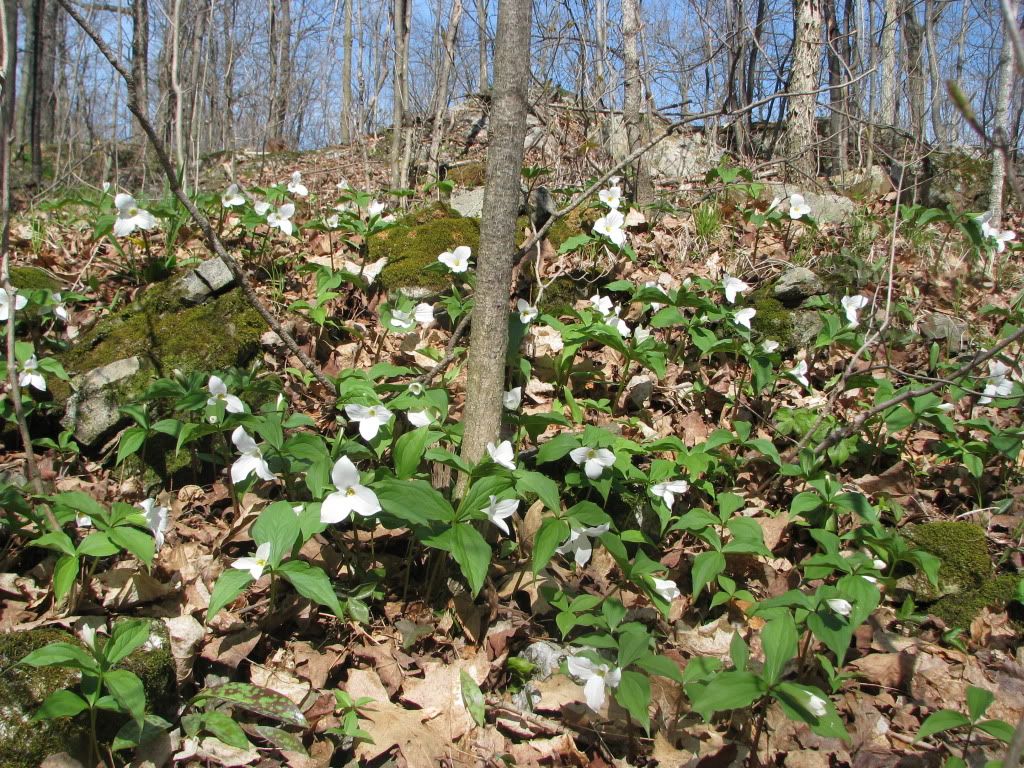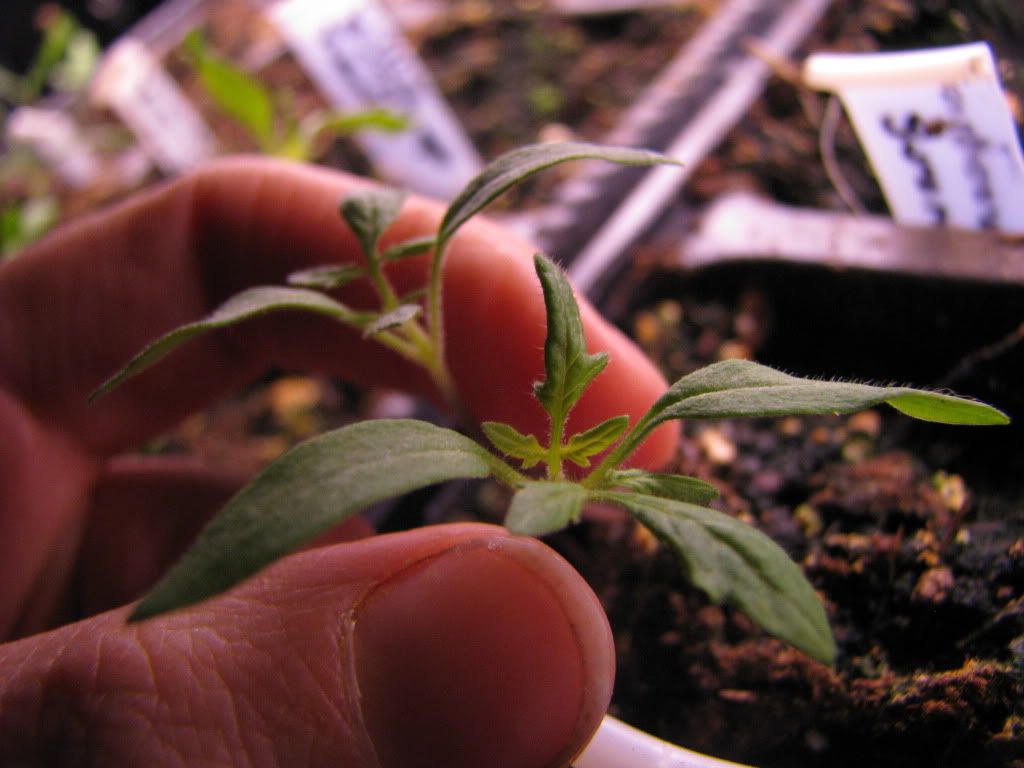
Rhubarb is almost ready and unperturbed by the surprise snowfall.
Plants are slowly waking up so I've been harvesting overwintered lettuce, spinach, parsnips, jeruselum artichokes, carrots and some chard. Green onions, horseradish, many herbs and violets are ready for harvest too. The forest is yielding more violets, trillium shoots (though who'd eat these beauties!) wild ramps, trout lily and fiddleheads though I haven't eaten the later two quite yet. Though the season of white barrenness is over and greens are abundant once again, today we got a reminder that the weather ride can be a roller coaster.
***
Some Spring Edibles:

Trout lilies in abundance, named for their spotted leaves.
Trout Lily (Erythronium americium): Got woodlands or anything kinda shady next to something that was once wood-ish then you probably have a carpet of trout lilies. They are known as a marginal edible or sometimes as starvation food which has put me off them until now. Though these guys give a description that sounds rather pleasant. the3foragers bloodspot eat trout lily By the way, kudos to this blog for info and delicious looking recipes.
Trilliums (Trillium grandiflorum): A bit passed their edibility now, the spring shoots really do taste a bit like sunflower seeds. I know I sparingly tried them once. I do have enough here to eat with a bit more abandon I suppose but I am reluctant cause they're so darn lovely.
Ramps - aka wild leeks (Allium tricoccum): If you have some woods or are lucky enough to have purchased some wild leeks for your shady garden at home, then these are a yummy and useful early spring treat. Use sparingly so there will be lots for next year. Normally I just eat odd leaf and don't harvest the bulb. GardenofEaten gives you a wild ramp eyeful.
Nettles (Urtica dioica): Any child who lives in an area where these grow abundantly, can tell you which ones they are after a couple of encounters. They are mineral accumulators and therefore quite nutritious. Spring pea, asparagus and nettle lasagna from The Bitten World and Barbara Pleasant talks writes about growing and using stinging nettles.
Dandelion (Taraxacum officinale): I'm going to presume you don't need help identifying these common plants but many people nonetheless are reluctant to scarf them down. The roots, leaves and flowers are both edible and medicinal. Spring leaves are more mild than they are after flowering but you can blanch them like you would for endive to take out some of the bitterness. I find that it isn't noticeable when cooked with mixed greens such as in a quiche or muffins. Motherearthnews is Wild About Dandelions or join Friends of Taraxacum on Facebook.
Japanese Knotweed (Polygonum cuspidatum): An introduced invasive you may have it in your yard or find it in an uncontaminated wild place. The spring shoots are eaten and I've heard they are similar to rhubarb. I've not been lucky enough to ingest any yet. Here's a meal from food underfoot that combines garlic mustard, japanese knotweed and stinging nettles.
Yellow/Curly Dock (Rumex crispus): I loved these plants when I was a child with their heavy dried seed heads to strip and sprinkle like brown snow onto the ground. Little did I know they were edible. Wild fermented curly dock leaves.

Trilliums, the provincial flower of Ontario being stately. In a week, the forest will be covered with them.
Chickweed (Stellaria media): Another nutritious, edible and mild tasting green that is often pulled out of the garden without a thought to its usefulness. Chick chick pate from eat weeds
Plaintain (Plantago major): Tough little plant often found in the lawn. It's young leaves may be eaten. Older leaves are stronger tasting and fibrous. You can use the seeds too as in this recipe from eat weeds.
Fiddleheads (Matteuccia struthiopsteris): The young uncurling fronds of ostrich and cinnamon ferns. Eat sparingly and cooked! as there are mixed results on the goodness of these even from the safe varieties. Recipes from fiddleheads.ca

These small white and lavender violets are scattered throughout one of our yards.
Violets (Viola species): All the purple/white flowered ones are edible including leaves and flowers. I've read that yellow violets can cause gastronomical distress. If caught at just the right time, the leaves of Viola odorata aren't bad either in my experience. Not Eating Out in New Yard eats violet leaves and other greens.
Garlic Mustard (Alliaria petiolata): An invasive weed, you are likely to have some of these even in the average suburban lot. The taste is described as a cross between - you guessed it garlic and mustard. Some recipes including the common garlic mustard pesto that I keep coming across.
Though hardly an exhaustive list but that's all I have time for now. Let me know if you've sifting through your lawn or woods for food lately.

